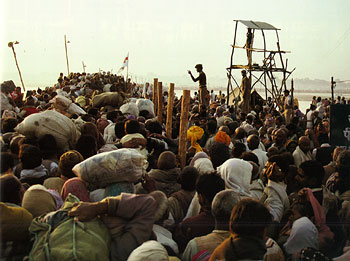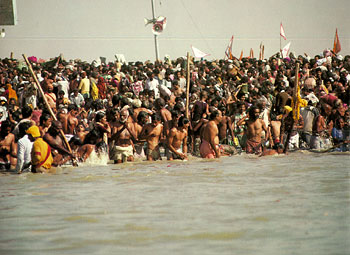






pilgrims came by the millions! Some arrived on overcrowded trains carrying five times normal capacity. Some came by bus, some by car, some by ox-drawn carts, and some rode on horses, camels, and even elephants. The rich and famous chartered private planes and helicopters; the less affluent came on foot, carrying their bedrolls and camping equipment in heavy bundles on their heads. Wave after wave, the pilgrims formed a veritable river of humanity that flowed onto the banks of the Ganges at Allahabad to celebrate the greatest spiritual festival ever held-the Kumbha Mela.
On this occasion, pilgrims from even the remotest
parts of India-speaking different languages and dialects, wearing distinctive
markings on their foreheads, donning various types of dress, and observing
different manners and customs-assemble for a holy bath in the sacred water
of the Ganges.

![]() Kumbha
Mela has gained international fame as "the world's largest act of faith."
Pilgrims attend this holy event with such tremendous faith and in such
overwhelming numbers that it could appear quite bewildering to one who
is experiencing it for the first time. Although there is no systematic
advertising for the event, Kumbha Mela unfailingly draws huge crowds.
Kumbha
Mela has gained international fame as "the world's largest act of faith."
Pilgrims attend this holy event with such tremendous faith and in such
overwhelming numbers that it could appear quite bewildering to one who
is experiencing it for the first time. Although there is no systematic
advertising for the event, Kumbha Mela unfailingly draws huge crowds.
Sidney Low, who visited the Kumbha Mela during the tour of the Prince and Princess of Wales in 1906, was wonderstruck. He wrote: "Nothing more impressive, picturesque, and pregnant with meaning and significance than Kumbha Mela can be witnessed in all of India."
India's own citizens are also impressed with the Kumbha Mela. Jawaharlal Nehru, India's first Prime Minister, wrote in Discovery of India: "In my old city of Allahabad I would attend the great bathing festival, Kumbha Mela, and see hundreds of thousands of people come, as their forebearers had come for thousands of years from all over India, to bathe in the Ganges."





